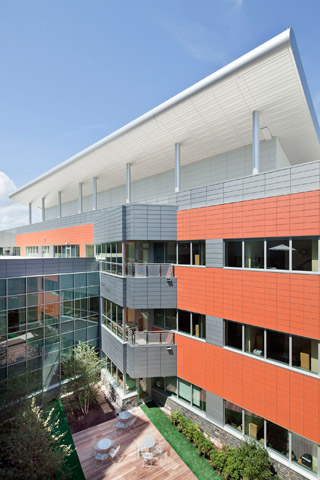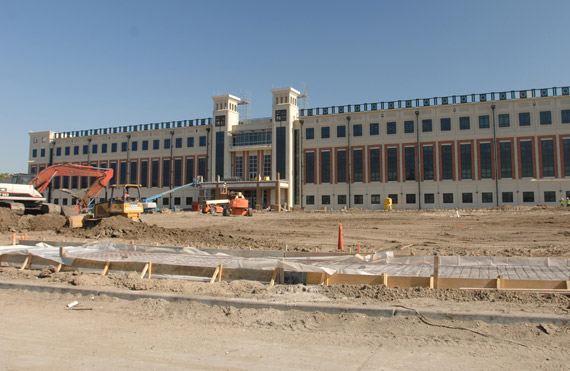HDR & Sustainable Design: The Implications of H.R. 1540 on DoD Projects
On January 2, 2012, President Obama signed into law the 2012 National Defense Authorization Act (NDAA), known as H.R. 1540. The final budget reflected lower spending levels than in recent years in response to the changing wars, the economy and politics. Funding requests were lowered; current funding and new requests were lowered and, in some cases, restrictions were placed on funding. One such restriction is a provision in H.R. 1540 that bans paying any cost premiums required for Leadership in Energy and Environmental Design (LEED) certification at the platinum and gold level for all future Department of Defense (DoD) buildings. Specifically, the provision states:
The provision is the result of intensive lobbying by domestic wood producers who have long fought against the regulatory use of LEED because of its sole recognition of Forest Stewardship Council (FSC)-certified wood in a voluntary credit worth one point out of the 110 available in any of the various U.S. Green Building Council (USGBC) certification products. Senator Roger Wicker (R-Miss), who introduced this provision to the 2012 NDAA, took issue with LEED’s exclusion of alternate wood certifications and focused on his perception that FSC certification lacked a broad enough standard. In a statement about his provision, Wicker said, “Standards should take into consideration the full life-cycle of wood products, including the environmental benefits provided by our domestic reforestation programs. After completing this study, the Department of Defense should use credible standards that more accurately assess U.S. wood products.”
The provision requires the Defense Department to submit a report to Congress on the energy efficiency and sustainability standards used for military construction and building repair. This includes an analysis of cost benefits, return-on-investment and long-term payback for LEED silver, gold, platinum and volume certification. Industry standards adopted by the American Society of Heating, Refrigerating and Air Conditioning Engineers (ASHRAE) and other American National Standards Institute (ANSI)-accredited standards also are to be analyzed in an effort to determine how best to provide verification for the various Federal sustainability and energy efficiency mandates and Executive Orders (EO).
Important exemptions have been built into the provision. First, the Secretary of Defense (SecDef) has the ability to overrule the certification restrictions. Given the history of the DoD in sustainable and high-performance building design principles as well as the LEED rating system, it may be reasonable to assume that a large, high-profile project might still be encouraged to achieve gold or even platinum certification as a matter of image.
Second, the law allows the SecDef to proceed with gold or platinum certification if the measures required to meet the higher certification levels are cost-effective and if it can be proven that any cost premiums can be made back in energy savings. It is this last exemption that holds the key to understanding how many projects each year will be able to avoid the consequences of H.R. 1540 restrictions. Many of the means to do so will be discussed below.
But beforehand, keep in mind the following:
- LEED certification level and silver certification efforts and project requirements are not affected by this provision;
- Projects funded in past years are not subject to the same restrictions placed on projects funded in 2012; and
- The stated restrictions do not exclude performance requirements as defined by other Federal environmental mandates, such as EPAct 2005, EISA 2007, EO 13514 or EO 13423.
Abiding by Federal Laws & Regulations
This last point is particularly salient considering many critical issues addressed by Federal mandates, such as energy efficiency measures and measurement and verification, represent much of the traditional premiums associated with sustainable design strategies.

Photo courtesy of HDR |Architecture, Inc.; © 2011 Ari Burling
The new Fort Belvoir Community Hospital has readily accessible, visible healing gardens located between each of the clinics and hospital tower.
This means that if certain costs are a direct result of meeting Federal mandate compliance standards, then these costs can no longer be considered premiums.
In addition to LEED credits earned by strict adherence to Federal sustainability requirements, many credits reflect an advanced market and accepted industry standard. These credits typically have no relative premium and often represent a short and favorable return-on-investment. When combined, then, a significant number of LEED credits become easily achievable. In a recent study completed by the Department of Veterans Affairs, which explored the transition from LEED for New Construction to LEED for Healthcare, it was found that points earned from just these two aspects are sufficient to achieve silver certification in both LEED systems with no other design or site conditions factored in.
Project specific site conditions and features also can result in a significant increase to a project’s LEED point total with no effect on cost or schedule. For example, if a project has access to mass transportation and is located within a short distance of many services, it can earn an additional 11 points beyond what is earned through design and construction efforts. This means that a project tracking silver certification can earn gold simply by being in the right location.
These relatively automatic LEED credits are great if a project is in a position to benefit from its location, or it lacks unique characteristics that may eliminate otherwise simple opportunities or where silver certification is all that is being pursued. How can shortfalls be overcome for all other potential projects that do fall within one of these categories?
Understand Premiums
Defining the word “premium” can have a tremendous impact on what costs may be subject to H.R. 1540’s restrictions. “Premium” is a relative concept that defines the cost differential between something proposed and what otherwise would have been provided as a baseline. If a project is subject to the stringent environmental performance standards of Federal mandates, then those requirements become the baseline, and a cost differential no longer exists between the environmentally preferred choice and minimum requirement.
An alternate way to look at this is to avoid placing low bars on the baseline solution or product. Integrating sustainability in the design from the beginning, as a matter of practice, allows for many of the sustainable strategies to set baseline costs. As before, if the baseline is the desired solution, then no premium exists to incorporate it. The more a project team can control the definition of baseline costs, the more opportunities exist to incorporate sustainable solutions in a project.
Design Practice, Design Process
Ultimately, managing loopholes like these can only address part of the issue. Sustainable strategies are always more cost-effective when incorporated early in the design and done through an integrated design process. This ensures the project develops around chosen strategies to maximize coordination of design elements and to reduce duplicated efforts and conflicts that often occur in a traditional, non-integrated process. By testing solutions throughout the process, a careful balance of sustainable strategies is created, which truly represent the unique characteristics of a particular project, rather than one-size-fits-all solutions that may be slapped on late in the process.
Energy modeling tools also should be utilized from concept through construction documentation with energy reduction solutions tested at each phase of development. This should be considered a design tool rather than a verification tool to show LEED and EPAct (Energy Policy Act) compliance. Constant feedback will better allow designers to create balanced solutions between complex and diverse systems like HVAC and lighting that is more functional and cost-effective. Do not underestimate the value of energy modeling as a design tool when cost and performance are important issues, as they are with DoD and other Federal agencies.

Courtesy Photo U.S. Navy|The new Marine Force Reserve headquarters building, a 417,000 square foot facility, has been awarded a LEED certification from the U.S. Green Building Council.
Minimum LEED Requirements
Not all projects are positioned to attempt a higher LEED certification, nor is this always appropriate. DoD currently mandates that, outside of extenuating circumstances, all projects must achieve LEED silver certification [Department of Defense Sustainable Buildings Policy Memorandum, 10.25.10]. In this way, LEED becomes a tool rather than an inspiration. Ultimately, LEED and Green Globes ratings are primarily used to verify projects meet minimum Federal requirements. For any number of reasons, this means many potential projects will never explore a higher certification level unless circumstances align, such that this happens with little or no effort.
These projects will never be subject to the restrictions H.R. 1540 places on LEED certification. Ironically, this demonstrates one last way to prevent the law from negatively impacting some projects that are, in fact, interested in pursuing a more stringent sustainability standard.
H.R. 1540 is triggered when a project passes the threshold between silver and gold. So, if a project chooses to target silver certification, additional costs associated with sustainability strategies beyond those needed for minimum certification, but not done to improve LEED standing, are not subject to the law’s restrictions. This does not mean that other cost controls will not take precedent. Both EPAct and EISA (Energy Independence and Security Act) still require reasonable payback be verified for additional costs, but this standard is less restrictive than H.R. 1540, thus allowing for projects to seek a higher level of sustainability than what might otherwise be possible because of the new law. In the end, the only sacrifice these projects may have to make is a LEED gold certification.
The bottom line is that H.R. 1540 does not need to represent restrictions or limitations on DoD projects. High-performance and environmentally sensitive buildings are still able to be constructed with many of these earning LEED gold certification without additional costs. LEED platinum certification may be out of the question, but the reality is that this is a rare occurrence anyway. LEED is only one measure of sustainable performance, and it is incumbent on all design and construction professionals to not lose sight of how the environment and our society measure our actions. The law does not need to limit innovation and creativity or compromise the desire to reduce the negative environmental impacts of buildings. In many ways it is simply calling into question the process behind sustainability, not the implementation, which will ultimately define our built environment.





























